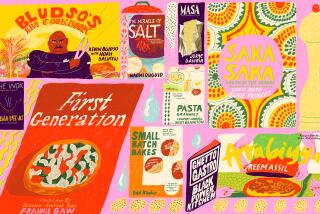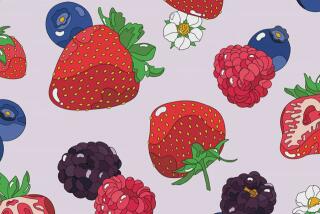The Finest Fruit of Winter
- Share via
Few fruits conjure a clearer and more distinct image than the pear. With its graceful, voluptuous contour, it is easily one of the most provocative and sensuous fruits in the world.
Pears beg for cold-weather flavor companions such as hazelnuts and pecans, brown butter and caramel, cinnamon and nutmeg. Their handsome colors and velvety texture inspire thoughts of cooking, baking, poaching and otherwise turning these delightful fruits into tempting edibles.
The pear is one of the most ancient of cultivated fruits. Originally grown in the area around the Caucasus Mountains between Russia and Turkey, the pear was spread by Aryan tribes as they migrated into Europe and northern India.
*
Pears are of the Pyrus genus and are closely related to apples and quince. The European varieties come from P. communis and P. nivalis. The Asian varieties, often called apple-pears, come from P. pyrifolia and P . ussuriensis. While the geographic development of Asian varieties occurred separately from the European, their parallel history makes them kindred fruits.
Traces of pear are evident as far back as 10,000 years ago in Ice Age dwellings found in Switzerland. One of the earliest written records of the fruit was made by Sumerian secretaries around 2750 BC. In the text they describe a thick paste made from pears, thyme and figs mixed with oil and ale to be made into a poultice and applied to the body.
The ancient Greeks held the pear in high esteem: Homer called the fruit “the gift of the gods,” In the 4th Century BC, the Greek naturalist Theophrastus, a student of Aristotle, wrote detailed information about the propagation of pears. Along with grapes and apples, pears were also a common fruit of imperial Rome. Records show that the Romans developed, or at least discovered, approximately 38 pear varieties and in turn introduced them to the nations of their vast empire. During this time, pears were customarily enjoyed after a meal, although some were pickled or preserved by being submerged whole in vessels of honey.
Chinese documentation of pears dates back to 1000 BC. In the 3rd Century, the writer Ko Nigung outlined the various Chinese pear varieties available, and 6th-Century writings feature descriptions of the different propagation techniques employed.
*
Until past the Middle Ages, pear cultivation in Europe was confined primarily to castle and monastery gardens, thus making pears a luxury item available to a select group. This aristocratic image was still associated with the fruit in the 17th Century, when pear growing in private orchards became a hobby for the wealthy. In France during this time, pear growing reached its zenith, when numerous new varieties were developed. In the 18th Century, the Belgians were the leading innovators. It was a Belgian, Nicolas Hardenpont, who stole the limelight in the 18th Century with the first butter pear varieties. Soft, ultra-juicy and flavorful, these pears were a vast improvement over existing varieties.
Colonial settlers introduced the pear to North America around 1629. Most of the European pear varieties grown in North America are more than 100 years old, and of the thousands of registered varieties, none are indigenous to the continent. All major commercially grown pears in the United States are descendants of European varieties or are hybrids created by crossing European with Asian strains.
Today, more than 5,000 varieties of domestic pears are grown throughout the world’s temperate zones. In the United States, the major commercial growing areas for European and Asian pear varieties are California, Oregon and Washington. France, which has long had a reputation for growing superior pears, is now the European leader in pear cultivation.
Although the appearance of pears in markets traditionally signals the arrival of autumn, modern packing and shipping procedures now enable us to have a year-round supply.
*
Because pears are one of the few fruits that actually ripen more successfully off the tree, they are picked when green and hard. (When left on the tree to ripen, the fruit becomes soft at the core and mealy.) This is a boon for growers, who can transport their crop with minimum damage. It also means that once purchased, you must allow pears time to ripen at home, a process that requires diligent monitoring, since pears move from a state of perfect ripeness to unpleasant spoilage with surprising speed.
Although people are most familiar with the greenish, yellow-skinned Bartlett or Packham varieties that are ubiquitous in supermarkets, there is actually much diversity in pear color and size. From the brownish-gold Bosc to the fiery Red Crimson, and from the amply proportioned yellow Anjou to the diminutive Seckel, each variety has a unique flavor, texture, color and size. Although I have suggested commonly available varieties for the recipes below, I encourage you to use some of the lesser-known pears also mentioned.
*
The combination of uncooked European and lightly cooked Asian pears adds a pleasing texture and sweet undertone to the spicy sausage filling in these cross-cultural won tons.
SAUSAGE AND PEAR WON TONS
2 shallots, finely chopped
2 small Asian pears (preferably Chojuro, Niitaka or Hosui), halved, cored and finely chopped
1 tablespoon mild-flavored olive oil
1/2 pound mild Italian sausage, removed from casings and finely crumbled
1 1/2 teaspoons ground fennel seeds
1 firm-but-ripe pear (preferably Packham, Bartlett or Winter Nelis), halved, cored and finely chopped
2 jalapeno chiles, stemmed, seeded and minced
1 clove garlic, minced
1/2 cup tomato paste
Salt
Freshly ground pepper
1/2 cup cold water
1/3 cup cornstarch
60 won ton skins
4 to 5 cups oil, for frying
To make filling, cook shallots and Asian pears in olive oil in large saute pan over high heat 2 minutes, stirring frequently. Add sausage and fennel seeds and cook 1 1/2 minutes, stirring frequently. Remove from heat. Add remaining pear, jalapenos, garlic and tomato paste. Mix well. Season to taste with salt and pepper. Let cool to room temperature.
Combine water and cornstarch in small bowl to form slurry.
Arrange 6 to 8 won tons on clean, dry, flat surface. Using pastry brush, brush each won ton with thin layer of slurry. Immediately place about 1 teaspoon filling at 1 corner of each skin. Loosely fold over to make triangle shape. Gently press each together, starting from inside and working toward outside edges, expelling any air as you go. Bring 2 long corners of triangle together and pinch together using some slurry. Make remaining won tons in this fashion.
Place 2 cups oil in heavy-bottomed, 6-quart pan. Oil should fill about 1/3 of pan. Heat over medium-high heat until hot but not smoking, 350 to 375 degrees. Add small batch of won tons. Cook 30 to 45 seconds or until golden brown. Remove with slotted spoon. Drain on paper towels. Transfer to oven-proof plate and keep warm in oven at 250 degrees.
Cook remaining won tons in small batches, adding more oil as needed. After adding new oil, wait until it returns to proper temperature before adding next batch of won tons. Serve won tons hot. Makes about 60 won tons or 8 to 10 servings.
Note : Won ton skins are available in some markets and in all Asian markets.
*
When paired with a loaf of warm bread and chunk of good cheese, this robustly flavored salad makes a wonderful cool-weather supper. If you can’t find arugula and frisee, substitute escarole and curly endive.
WARM GREEN SALAD WITH PEARS AND BACON
1 pound sliced bacon
1/4 cup walnut oil
2 1/2 tablespoons balsamic vinegar
1/2 cup fruity olive oil
1 large bunch arugula, trimmed, rinsed and dried
2 bunches frisee, trimmed, rinsed and dried
Salt
Freshly ground pepper
2 large firm--but ripe--pears (preferably Bartlett, Anjou or Comice), halved, cored and thinly sliced lengthwise
Cook bacon in large skillet until crisp. Remove with slotted spoon. Drain on paper towels. Coarsely chop and set aside.
Combine walnut oil and balsamic vinegar in very large bowl, whisking constantly with wire whisk to form smooth emulsion. Set aside until needed.
Heat olive oil in small saucepan over medium-high heat until oil begins to smoke. Add greens to bowl containing walnut oil mixture. Slowly drizzle hot olive oil over greens, tossing constantly with tongs.
Add bacon to warm greens and mix well. Season to taste with salt and pepper. Arrange on individual plates and top with pears. Serve immediately. Makes 6 servings.
*
This recipe makes enough stuffing for eight Cornish game hens. When preparing fewer than eight birds, transfer the extra stuffing to a lightly greased casserole dish and either cover tightly with aluminum and freeze for later use, or bake separately at 350 degrees 30 to 35 minutes or until thoroughly heated. Serve along with the stuffed birds as a side dish.
ROAST CORNISH GAME HENS WITH PEAR AND CORN BREAD STUFFING
1 medium onion, cut into small dice
2 cloves garlic, minced
1 tablespoon ground coriander
1/4 cup unsalted butter
3 tablespoons fruity olive oil
3 firm pears (preferably Bosc, Winter Nelis or Forelle), halved, cored and cut into 1/4-inch cubes
6 cups cubed store-bought corn bread stuffing
1 cup dry white wine
Salt
Freshly ground pepper
8 Cornish game hens, rinsed and patted dry
Place onion, garlic, coriander, butter and olive oil in very large, non-stick saute pan. Cook, stirring frequently, over medium heat 7 minutes or until onions are tender.
Add pears and cook over high heat 3 minutes, stirring constantly. Stir in corn bread stuffing and wine. Mix well. Reduce heat to medium. Cook 7 to 8 minutes longer, stirring occasionally with fork, until stuffing is moist and pears are almost tender. Remove from heat. Season generously to taste with salt and pepper. Let cool to room temperature before stuffing hens.
Using about 3/4 cup stuffing per hen, loosely fill cavity of each hen. (Do not pack stuffing inside birds. Stuffing expands as it cooks.) Using wood picks or trussing needle and heavy kitchen thread, close openings on each hen.
Lightly grease roasting pan large enough to accommodate all birds. Place large, flat roasting rack inside roasting pan and set birds, breast side down, on rack. (If pan is too small for all 8, use 2 pans, but rotate pans between oven shelves during cooking to ensure even cooking.)
Place in lower 1/3 of oven. Roast at 450 degrees 15 minutes. Reduce heat to 350 degrees. Remove pan from oven. Turn hens over so that breast sides are facing upward. Return to oven and roast 20 to 25 minutes or until leg juices run clear when pierced with sharp knife. Remove from oven. Let stand 5 minutes before serving. Makes 8 servings.


